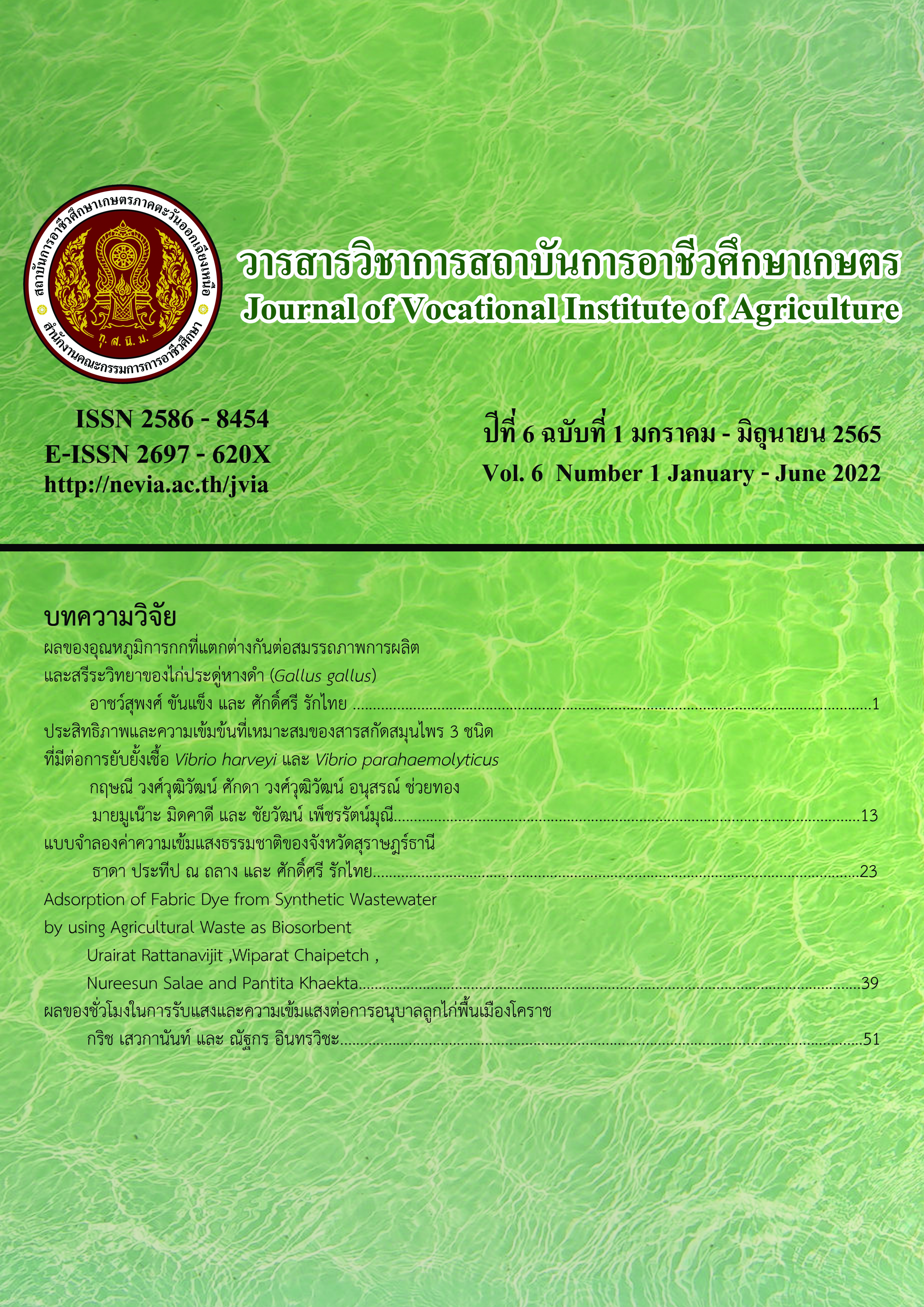Adsorption of Fabric Dye from Synthetic Wastewater by using Agricultural Waste as Biosorbent
Main Article Content
Abstract
ABSTRACT
The objective of this research was to study the appropriate conditions for the absorption efficiency of local agricultural wastes : corn cob, pomelo peel, pineapple peel and longan peel with the following factors, pH of synthetic wastewater, concentration of synthetic wastewater, absorption time, amount of absorbent material and suitability for absorption synthetic fabric dyes. The results showed that 4 types of agricultural wastes had different absorption efficiency and different absorption factors. It was found that corn cob had the best absorption efficiency of fabric dye. At the appropriate of pH 7, corn cob had an efficiency of 74%. The appropriate concentration of synthetic wastewater affecting the absorption efficiency of corn cob was 2 mg/l with an absorption efficiency of 83%. The amount of 1 g of absorbed material had an efficiency of 88%. The best absorption time of the corn cob was 15 minutes with an efficiency of 92%. The results of the study on the correlation of the absorption efficiency of each parameter showed that there was a relation between corn cob and longan peel in pH, concentration, absorbent content and time. Corn cob was the most appropriate material as the Pearson correlation coffeicient was 1 and its significant value was 0.00. The results of the study of agricultural waste materials used showed that pineapple peels had the lowest absorption efficiency of the waste materials at less than 70%
Keywords : synthetic wastewater, adsorption, fabric dye, corn cob, longan peel, pineapple peel, grapefruit peel
Article Details

This work is licensed under a Creative Commons Attribution-NonCommercial-NoDerivatives 4.0 International License.
The content and information in articles published in the Journal of Vocational Education in Agriculture are the opinions and responsibility of the article's author. The journal editors do not need to agree or share any responsibility.
Articles, information, content, etc. that are published in the Journal of Vocational Education in Agriculture are copyrighted by the Journal of Vocational Education in Agriculture. If any person or organization wishes to publish all or any part of it or to do anything. Only prior written permission from the Journal of Vocational Education in Agriculture is required.
References
Kulida Sa-ard (2014). The efficiency of Copper(II) Ions Sorption using Biochar in Wastewater Treatment from Textile Industry. (Master thesis, National Institute of Development Administration).
Chandra, T.C., et al. (2009). Activated Carbon from Durian Shell: Preparation and Characterization. Journal of the Taiwan Institute of Chemical Engineers, 40(4), 457–462.
Ferreira, A. M., et al. (2014). Complete removal of textile dyes from aqueous media using ionic-liquid-based aqueous two-phase systems. Separation and Purification Technology, 128, 58-66.
Ministry of Agriculture Cooperatives. (2017). Longan and pomelo. Bureau of Agricultural Economic Research.
Chakravarty, P., Bauddh, K., & Kumar, M. (2015). Remediation of Dyes from Aquatic Ecosystems by Biosorption Method Using Algae. In B. Singh, K. Bauddh, & F. Bux (Eds.), Algae and Environmental Sustainability, New Delhi: Springer India.
Argun, M. E., et al. (2014). Adsorption of Reactive Blue 114 dye by using a new adsorbent: Pomelo peel. Journal of Industrial and Engineering Chemistry, 20(3), 1079-1084.
Wanna, S. (2020). Adsorption of cadmium ions by agricultural waste. (Master thesis, Ubon Ratchathani Rajabhat University).
Suphakit, S. (2017). Adsorption of malachite green and reactive red 31 from synthetic wastewater by using banana peel adsorbents. (Master thesis, Silpakorn University).
Prawit, N. & Piyawan, N. (2005). The adsorption of Lead and Cadmium from Wastewater by using Dregs of Sagu palm (Metroxylon sagu Rottb) as Adsorbents. Applied Environmental Research, 27(2), 11-20.
Prachaub, C. & Buncha, C. (2007). Use of Longan Peel as an Adsorbent for Metal ion (Cadmium and Lead) Adsorbtion in Aqueous Solution. In 45th KASETSART UNIVERSITY ANNUAL CONFERENCE (p. 858-866). Bangkok: Kasetsart University.
Rattaphol, H., et al. (2019). Removal of lead from synthetic wastewater by Phaeo
leaf sorbent (Research reports). Bangkok: Rajamangala University of Technology Krungthep.
Moubarak, F., et al. (2014). Elimination of Methylene Blue Dye with Natural Adsorbent Banana Peels Powder. Global Journal of Science Frontier Research: B Chemistry, 14(1), 39-44.
Patcharanan, C., et al. (2020). Adsorption of methylene blue dye of pomelo peel charcoal prepared from kiln-style furnace. academic and research journal, 14(1), 15-25.
Piyanuch, K. (2014). Adsorption of lead in solution with sodium hydroxide treated giant mimosa pods. (Master thesis, Mahasarakham University)
Prachuap, C., et al. (2004). The use of longan bark as an ion absorber of cadmium and lead in water contaminated with heavy metals. Research and Promotion Journal Agriculture, 22(Special), 156–166.

